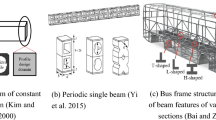Abstract
Regarding increasing applications with mass quantities, diverse specifications, and close quality tolerance, the precision bending of large diameter thin-walled (LDTW) Al-alloy tube should be efficiently achieved. However, bending of LDTW Al-alloy tube is a highly tri-nonlinear process with possible multi-defect, needing strict coordination of various bending tools and processing parameters. Considering the coupling effects of various forming parameters on multiple defects, this study developed a knowledge-based substep methodology to solve the deterministic optimization of LDTW Al-alloy tube bending with multi-objective and multi-variable under multiple factor constraints. Considering narrow forming window under small bending radii (R b < 2D, R b—bending radius, D—initial tube diameter), a finite element (FE)-based stepwise iterative search method is proposed to optimize key forming parameters of LDTW Al-alloy tube under small R b, and the search direction is based on bending knowledge. While for large R b bending with wide optional ranges of forming parameters, a hybrid optimization approach is used by combining virtual design of experiment, FE simulation, approximate response surface model, sequential quadratic programming algorithm, or genetic algorithm. Using orthogonal experimental method, three-dimensional (3D)-FE simulation, experiential data, and analytical formulae, knowledge on key forming parameters, coupling effects on multiple defects, effect significance, and design rules are obtained as well as initial values and design ranges. By several practical bending scenarios with D up to 100 mm, the proposed substep deterministic optimization methodology for LDTW Al-alloy tube bending is evaluated.
Similar content being viewed by others
References
Yang H, Li H, Zhang ZY, Zhan M (2012) Advances and trends on tube bending forming technologies. Chinese J Aeronaut 25:1–12
Li H, Yang H, Yan J, Zhan M (2009) Numerical study on deformation behaviors of thin-walled tube NC bending with large diameter and small bending radius. Comp Mater Sci 45(4):921–934
Jin Z, Luo S, Fang XD (2001) KBS-aided design of tube bending process. Eng Appl Artif Intel 14:599–606
Strano M (2005) Automatic tooling design for rotary draw bending of tubes. Int J Adv Manuf Technol 26:733–740
Johansson J (2006) Automated design of tools for rotary draw bending: an approach based on generic CAD-models driven by heuristic and algorithmic knowledge. Efficiency Development of Manufacturing Machines 2006; 6(3): 86–96. In: International Conference on Efficient Development of Manufacturing Machines and Processes. Wroclaw, Poland
Beauchesne E, Safieddine M, Marin G, Herbay E (2007) Sensitivity analysis and optimization of tube bending coupled with pressure test. AIP Conf Proc 908:461–466
Kim J, Chung KH, Lee W, Kong J, Ryu H, Kim D, Kim C, Wenner ML, Chung K (2009) Optimization of boost condition and axial feeding on tube bending and hydro-forming process considering formability and spring-back. Met Mater Int 15(5):863–876
Lăzărescu L 2010. FE simulation and response surface methodology for optimization of tube bending process. The Annals of “Dunărea de Jos” University of Galaţi Fascicle V, Technologies in Mechanical Engineering, ISSN 1221-4566 93-100
Mentella A, Strano M, Gemignani R (2008) A new method for feasibility study and determination of the loading curves in the rotary draw-bending process. Int J Mater Form 1:165–168
Ankur K (2008) Optimizing the rotary draw tube bending process to avoid wrinkles. Int J Modelling Simul 28(3):281–291
Xu J, Yang H, Zhan M, Li H (2011) Design and optimisation of mandrel parameters for thin walled aluminium alloy tube NC bending. Mater Res Innov 15:s365–s369
Xu J, Yang H, Li H, Li H (2012) Significance-based optimization of processing parameters for thin-walled aluminum alloy tube NC bending with small bending radius. Trans Nonferrous Met Soc China 22:147–156
Skrikerud M (2007) Optimization in Tube Forming. Forming Technology Forum 2007—Application of Stochastics and Optimization Methods. March 14–15, IVP, ETH Zurich, Switzerland
Hwang HY, Jung KJ, Kang IM, Kim MS, Park SI, Kim JH (2006) Multidisciplinary aircraft design and evaluation software integrating CAD, analysis, database, and optimization. Adv Eng Software 37(5):312–326
Jansson T, Nilsson L (2006) Optimizing sheet metal forming processes—using a design hierarchy and response surface methodology. J Mater Process Technol 178:218–233
An H, Green DE, Johrendt J (2010) Multi-objective optimization and sensitivity analysis of tube hydroforming simulations. Int J Adv Manufact Technol 50(1–4):67–84
Bahloul R, Mkaddem A, Santo PD, Potiron A (2006) Sheet metal bending optimisation using response surface method, numerical simulation and design of experiments. Int J Mech Sci 48(9):991–1003
Li H, Yang H, Liu K (2012) Towards an integrated robust and loop tooling design for tube bending. Int J Adv Manuf Technol. doi:10.1007/s00170-012-4258-1
Selvakumar S, Arulshri KP, Padmanaban KP, Sasikumar KSK (2012) Design and optimization of machining fixture layout using ANN and DOE. Int J Adv Manuf Technol. doi:10.1007/s00170-012-4281-2
SAE Aerospace, An SAE International Group. Aircraft Tube Bending Methods, Techniques and Tooling. Aerospace information report. Air5378, issued 1999-12, reaffirmed 2004-06
Li H, Yang H, Zhan M, Gu RJ (2007) The interactive effects of wrinkling and other defects in thin-walled tube NC bending process. J Mater Process Technol 187–188:502–507
Li H, Yang H, Zhan M, Sun ZC, Gu RJ (2007) Role of mandrel in NC precision bending process of thin-walled tube. Int J Mach Tool Manuf 47(7–8):1164–1175
Bend Tooling Inc (2007) Bending formulas. http://www.bendtooling.com/bending_formulas.htm
Oliveira DA, Worswick MJ, Grantab R (2005) Effect of lubricant in mandrel rotary draw tube bending of steel and aluminum. Can Metall Quart 44:71–78
Author information
Authors and Affiliations
Corresponding author
Rights and permissions
About this article
Cite this article
Li, H., Yang, H., Xu, J. et al. Knowledge-based substep deterministic optimization of large diameter thin-walled Al-alloy tube bending. Int J Adv Manuf Technol 68, 1989–2004 (2013). https://doi.org/10.1007/s00170-013-4811-6
Received:
Accepted:
Published:
Issue Date:
DOI: https://doi.org/10.1007/s00170-013-4811-6




